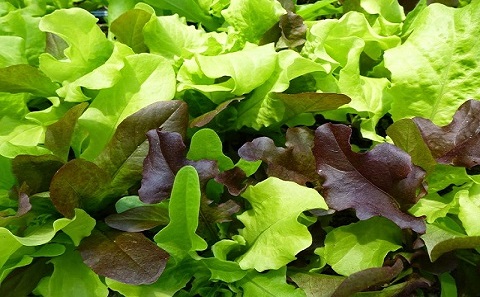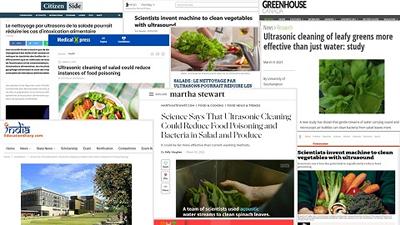Reducing human illness and fatalities through novel ultrasonic cleaning of salad

A new research paper details pioneering evidence in the potential to reduce instances of food poisoning, using just sound, air and water.
Streams of water, carrying sound and microscopic air bubbles, were used to clean naturally-occurring (i.e. already present on the farmed produce, and not added in the lab) bacteria from salad.
Salad and other fresh produce are unsuitable for sterilization by cooking and chemicals. This in turn has implications for the rise of antimicrobial resistance (samples from humans infected in the fatal Romaine lettuce poisonings in the USA in 2018 and 2019 were infected with antibiotic resistant strain).
The study also showed the potential of these streams to extend food shelf life, which has important economic implications, but also is a key tactic in meeting the global plan to feed an extra 2 billion people by 2050, given that around half (by weight) of today’s food spoils before it can be consumed.
Detail
A diet containing uncooked salad, fruit and vegetables is key to reducing a range of conditions, including cardiovascular diseases, Type II diabetes and certain types of cancer.
However salad and leafy green vegetables may be contaminated with harmful bacteria during growing, harvesting, preparation and retail leading to outbreaks of food poisoning which may be fatal in vulnerable groups. In the US, Shigella toxin producing E coli 0157 and Salmonella spp are the most common causes of these outbreaks with Listeria and Cyclospora also implicated [REF: Centres for Disease Control 'Lettuce, Other Leafy Greens, and Food Safety' ].
Because there is no cooking process to reduce the microbial load, washing is vital (by the supplier and the consumer). However washing with soap, detergent bleach or other disinfectants are not recommended. The crevices in the leaf surface means washing with plain water may not be effective in removing harmful bacteria and may leave an infectious dose on the leaf. Even in countries where washing with a chemical load is the norm, the chemical may not penetrate the crevices where microbes reside, and may simply leave them resident on the food in a VBNC (viable but non-culturable) state. This is particularly problematic, because culture checks performed by the suppliers to assure themselves that the microbial load is not dangerous, may underestimate the risk, because VBNC microbes do not grow in standard culture tests but can still cause illness in a human or animal consuming the food product.
Removal of the microbe from the leaf, especially from within crevices, is therefore preferable. A recently published paper* demonstrates how this can be done, via a collaboration between Sloan Water Technology Limited (SWT), Vitacress and the University of Southampton, a collaboration formed and supported by Global-NAMRIP (the Global Network for Antimicrobial Resistance and Infection Prevention).
The paper can be downloaded for free until April 16, 2021 using the following link: https://authors.elsevier.com/a/1ceLt14aKMo9v9
Professor Leighton, inventor of the technology and leader of the study, explains: “Our streams of water carry microscopic bubbles and ultrasound down to the leaf. There the ultrasound sets up sound fields at the surface of the leaves, and within the leaf crevices, that attract the microbubbles towards the leaf and into the crevices. The ultrasound also causes the walls of the microbubbles to ripple very quickly, turning each bubble into a microscopic 'scrubbing' machine. The rippling bubble wall causes strong currents to move in the water around the bubble, and sweep the microbes off the leaf. The bacteria, biofilms, and the bubbles themselves, are then rinsed off the leaf, leaving it clean and free of residues.”
PhD student Weng Yee (Beverly) Chong said: “I am very grateful to Vitacress and EPSRC for funding my PhD. I came from an engineering background, and took Professor Leighton’s classes, but he told me that I could be a trans-disciplinary PhD student, and become a microbiologist whilst increasing, my engineering skills. I am also very grateful to Sloan Water Technology that they have opened up their laboratories to use by students like me, so that I can keep working on my experiments and progress with my PhD with minimal impact, even when the University labs are closed because of the pandemic. It is an exciting environment to work in because they are doing so much inventive work to combat the pandemic and infections as a whole.”
The paper is Beverly's second as a first author during her PhD, the first paper 'Improving livestock feed safety and infection prevention' being on validating ultrasonic stream to reduce the infection risk to horses and other livestock through hay cleaning.
The work was sponsored by Vitacress, whose Group Technical Director Helen Brierley said: “Ensuring food safety for our products is an essential requirement. At Vitacress, we wash our produce in natural spring water, and this type of ground-breaking new technology helps to enhance our process whilst ensuring our commitment to protect the environment is maintained. We are always interested in new developments and are excited to see the results of this research”.
Recent outbreaks
Outbreaks associated with fresh produce increased from fewer than 20 in the 1970s, to more than 100 in the 1990s. There were 5 reported deaths when 210 people were infected across Canada and 35 US states (96 hospitalized, including 27 who developed haemolytic uremic syndrome) with the O157:H7 strain of E. coli on Romaine lettuce from the Yuma growing region, in an outbreak lasting from March to June 2018. Despite this, in the following year (September 2019-January 2020) an outbreak of the O157:H7 strain of E. coli on Romaine lettuce from the Salinas Valley growing region in California infected 167 people across 27 states (with 85 hospitalizations including 15 people who developed haemolytic uremic syndrome).
It is also of concern that in the 2018 outbreak, genes for antibiotic resistance to chloramphenicol, streptomycin, sulfisoxazole, tetracycline, and trimethoprim-sulfamethoxazole were found in isolates from 184 ill people identified. Genes for antibiotic resistance to ampicillin and ceftriaxone were also found in isolates from four of those ill people. In the 2019 outbreak, bacterial isolates containing antibiotic resistance genes were obtained from 2 of the 159 patients studied, one for ampicillin, and one with combined resistance for ampicillin, chloramphenicol, streptomycin, sulfisoxazole, and tetracycline. Therefore, it is crucial to investigate ways to improve the microbiological safety of ready-to-eat (RTE) salads to reduce the risk of foodborne diseases.
The publication
The acoustic water streams were invented by Professor Leighton at the University of Southampton, who is now Director and Inventor-in-Chief of Sloan Water Technology Ltd., the company that owns the technology. The original pump-priming project to test salad cleaning by these stream was funded by Global-NAMRIP, and conducted by Professor Leighton and Dr Tom Secker. This provided the data needed to complete the collaboration, with the addition of Vitacress who funded a PhD studentship (filled by Weng Yee Chong) to provide a full dataset. Dr Craig Dolder (Chief Scientist at Sloan Water Technology Ltd.) and Professor Bill Keevil (School of Biological Sciences) completed the author team.
*Chong, W. Y., Secker, T. J., Dolder, C. N., Keevil, C. W. and Leighton, T. G. (2021) The possibilities of using Ultrasonically Activated Streams to reduce the risk of foodborne infection from salad. Ultrasound in Medicine and Biology (doi: 10.1016/j.ultrasmedbio.2021.01.026)

Tthththth this the name of some stuff and lllll